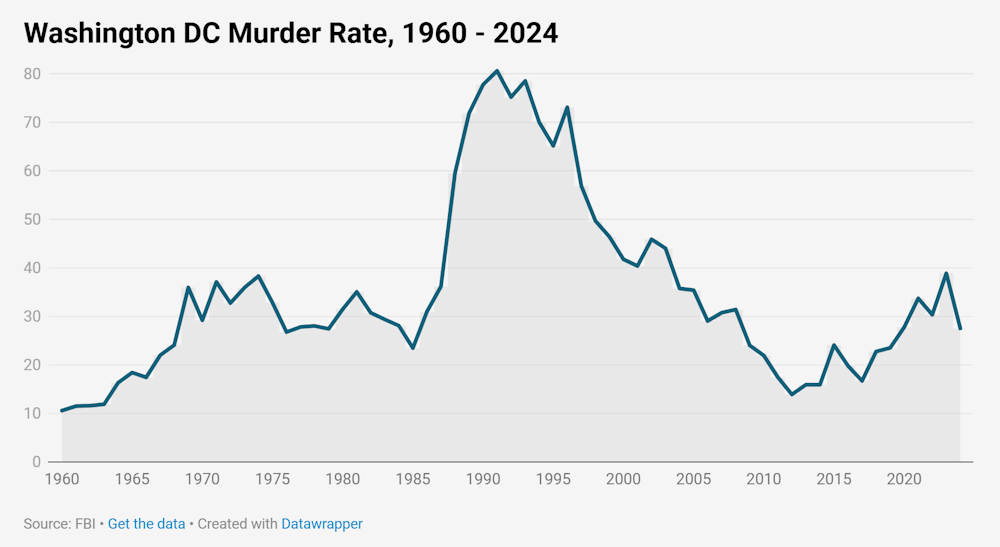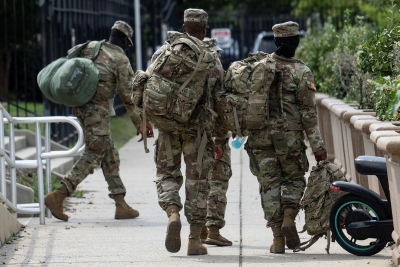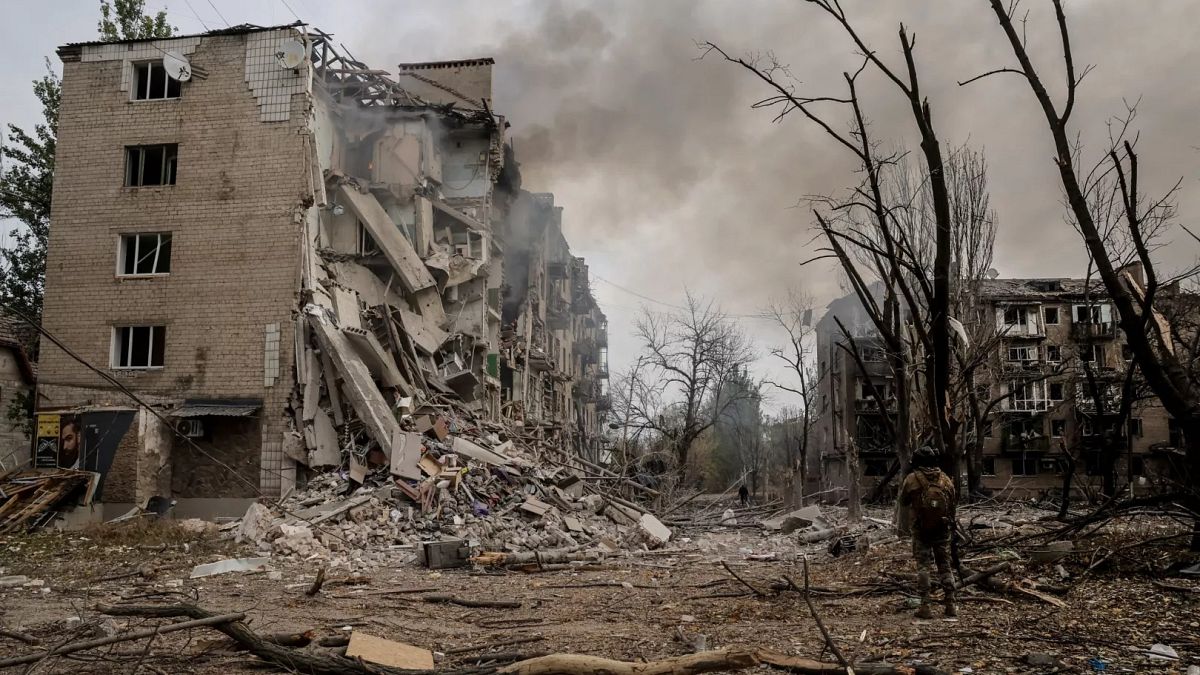President Donald Trump inaccurately claimed that the murder rate in Washington, D.C., “reached the highest rate probably ever” in 2023, and he ignored a decline in murders since then to justify a federal takeover of the city’s law enforcement.
In declaring a “crime emergency” in Washington, Trump wrongly claimed at an Aug. 11 press conference, “Murders in 2023 reached the highest rate probably ever. They say 25 years, but they don’t know what that means because it just goes back 25 years.”
Trump signed an executive order to take federal control of the Metropolitan Police Department for at least 30 days and issued a memo to deploy District of Columbia National Guard troops.
The city’s murder rate did increase in 2023 to the highest rate in 20 years, but it wasn’t the highest ever. And murders have decreased since.
Statistics released by the Metropolitan Police Department on the same day as Trump’s remarks showed the number of homicides had decreased by 32% from 2023 to 2024 and by 12% so far from 2024 to 2025. In addition, the U.S. Attorney’s Office for the District of Columbia reported in January that violent crime overall for 2024 was down 35% from the previous year and was “the lowest it has been in over 30 years.”
Jeff Asher, a co-founder of AH Datalytics, a data consulting firm that produces an aggregation of crime data provided by law enforcement agencies around the country, told us Trump’s claim about murders hitting an all-time high in Washington “is not accurate. DC’s murder rate in 2023 was 39 per [100,000] which was the highest in the city since 2003. That was still down more than 50% from 1991’s murder rate of more than 80 per 100K when the city had 482 murders. It has also since fallen and is on pace with 2019’s pace so far in 2025,” Asher, a former CIA analyst, said via email.

Adam Gelb, president and CEO of the Council on Criminal Justice, an independent think tank, also told us, citing FBI data, that Washington’s murder rate “peaked in 1991 at 80.6 and was at 38.9 in 2023 and 27.5 in 2024.”
A report issued by CCJ following Trump’s announcement of a federal takeover of Washington’s police department said that “overall, there is an unmistakable and large drop in reported violence in the District since the summer of 2023, when there were peaks in homicide, gun assaults, robbery, and carjacking. That downward trend is consistent with what’s being reported in other large cities across the country, while the level of violence in Washington remains higher than average in our sample.”
The CCJ report said, “The homicide rate in DC fell 19% in the first half of this year (January-June 2025) compared to the similar period last year.”
Overall in the U.S., violent crime and murder rates peaked decades ago and are much lower in recent years, as we’ve written. There was a spike in violent crime, particularly murders, in 2020 nationwide, partly due to the economic fallout of the COVID-19 pandemic, experts have said. Violent crime has decreased nationwide since, but Washington saw an uptick in 2023.
Trump’s executive order also said, “Crime is out of control in the District of Columbia,” and referred to “rising violence” and an “increase in violent crime.” But again, that ignores a recent drop in crime.
The Metropolitan Police Department’s “2025 Year-to-Date Crime Comparison” on Aug. 11 showed a 50% reduction in sex abuse cases, a 20% reduction in assaults with a dangerous weapon, a 28% reduction in robberies and a 26% reduction in overall violent crime.
At a press conference after Trump’s announcement, Washington Mayor Muriel Bowser noted the longstanding “rhetoric about the city” from the White House. “We also know that we are not experiencing a spike in crime but a decrease in crime,” Bowser said.
In an Aug. 11 Substack post, Asher wrote that the police department’s published data is probably overstating the size of the recent violent crime drop, because of differences in the crime categories, compared with what’s reported to the FBI. “That’s not inherently problematic, but comparing what is being published by DC to the numbers being reported to the FBI suggests that the department’s website is overstating the decline in violent crime over the last two years,” Asher wrote. “Violent crime is still declining, but probably not as much as is being reported.”
He said, “There’s still tons of evidence pointing to declining violent crime in DC in 2025, especially gun violence.”
Citing Washington’s 2023 murder rate, Trump also misleadingly said, “The murder rate in Washington today is higher than that of Bogota, Colombia, Mexico City, some of the places that you hear about as being the worst places on Earth, much higher.” He added later, “We doubled up on Baghdad; Panama City; Brasilia; San Jose, Costa Rica; Bogota, Colombia, heavy drugs; Mexico City I mentioned; Lima, Peru; all double and triple what they are. … D.C., 41 per 100,000, No. 1 that we can find anywhere in the world. Other cities are pretty bad, but they’re not as bad as that.”
But Asher said, “It’s generally inadvisable to compare crime rates between cities, especially international cities with populations many times that of DC.”
The homicide rate in the nation’s capital was the fourth highest among 24 U.S. cities in 2024, according to a report by the Center for Public Safety Initiatives at Rochester Institute of Technology that relied on local news reports and individual agency data. The three cities with higher rates than Washington were St. Louis, New Orleans and Detroit.
Asher wrote in a New York Times column in 2019 that crime reporting practices “can influence perceptions of crime as much as actual crime trends do. And decisions about where to draw a city’s borders and which offenses to count as official crimes can matter as much as how many crimes were reported in a given year.” Some cities include sprawling suburbs within their city limits, he noted, and while the core of a city might have a high crime rate, “the numbers from suburban areas can bring rates down.”
An area where the president more accurately portrayed a spike was in crimes against car owners, citing an Aug. 3 assault on a former Department of Government Efficiency employee during an attempted carjacking in northwest Washington. “The number of car thefts has doubled over the past five years and the number of carjackings has more than tripled,” Trump said at his Aug. 11 press event.
“This is an accurate description,” Asher told us. “Both car thefts and carjackings have fallen considerably after peaking in 2023, but both crimes remain well above pre-surge [pandemic] levels. Carjackings are falling fast again in 2025 though auto thefts are no longer falling at the moment.”
The CCJ report on crime in Washington showed “carjacking rose markedly during 2020 and spiked to a peak of 140 reported incidents, a rate of 20.6 per 100,000 residents, in June 2023. In June 2025, there were 36 reported incidents, or a rate of 5.1, a rate reduction of 75%.”
Role of National Guard/Federal Officers
There are a few aspects to Trump’s actions regarding policing in Washington, D.C. He took control of the Metropolitan Police Department, boosted federal law enforcement officers’ presence in the city and activated the D.C. National Guard.
In an executive order, Trump invoked the Home Rule Act to take federal control of the Washington police department. The 1973 law gives the president the power to do so when he “determines that special conditions of an emergency nature exist which require the use of the Metropolitan Police force for Federal purposes.”

Federal control can last for 30 days, provided that Trump notifies congressional committees with jurisdiction over Washington within two days of the order. If the president wants to maintain federal control after 30 days, Congress would need to pass a resolution.
Stephen Vladeck, a professor at Georgetown University Law Center, wrote in a Substack post that “the authority is simply to use the MPD ‘for federal purposes.’ In other words, the President can borrow the MPD for his own priorities; but he can’t control how they discharge their other duties.”
White House Press Secretary Karoline Leavitt said in an Aug. 12 press briefing that the federal government plans “to work with the Metropolitan Police Department” and that the Drug Enforcement Agency administrator, Terry Cole, is now “head of the chief of the Metropolitan Police Department.” Leavitt said Cole is “working with the [police] chief to ensure that law enforcement officers are allowed to do their jobs in the city.”
Trump said that 500 federal law enforcement agents, including from the FBI, DEA, Secret Service and Department of Homeland Security, were dispatched to Washington the week prior to his executive order.
In the press briefing, Leavitt said that about “850 officers and agents were surged across the city” the evening of Aug. 11 and made 23 arrests for “homicide, firearms offenses, possession with intent to distribute narcotics, fare evasion, lewd acts, stalking, possession of a high capacity magazine,” as well as traffic offenses and a bench warrant. She said that six illegal handguns were confiscated.
As for the National Guard, the president is the commander in chief of the D.C. National Guard. Trump issued a memo to the secretary of defense directing him to mobilize district guard troops “until I determine that conditions of law and order have been restored in the District of Columbia.” The Defense Department said that about 800 soldiers were activated on Aug. 11. “Duties for those personnel include administrative and logistical roles, as well as providing a physical presence in support of law enforcement,” DoD said.
U.S. Army spokesman Col. Dave Butler told the Washington Post that the soldiers, who will work in shifts of 200 personnel at a time, would provide a supportive role for the city’s police and could stand at street intersections to discourage crime.
Editor’s note: FactCheck.org does not accept advertising. We rely on grants and individual donations from people like you. Please consider a donation. Credit card donations may be made through our “Donate” page. If you prefer to give by check, send to: FactCheck.org, Annenberg Public Policy Center, P.O. Box 58100, Philadelphia, PA 19102.
Source link
